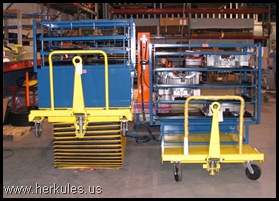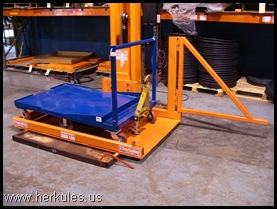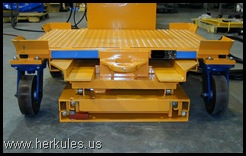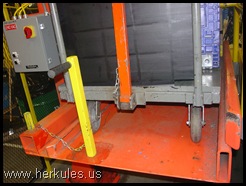(10014) I have seen hundreds of scissor lift table applications and cart applications over the years. In most cases, the best workstation solution requires the integration of the lift with the cart to ensure the operator picks from the correct ergonomic work height.
The information below describes an interface method to be used for lifting a cart with a scissor lift table from the center of the cart frame (shown in diagram-01) along with another method of lifting a cart with a post lifting system (PLS) which lifts the cart from the caster wheels (shown in diagram-02).
(diagram-01)
(diagram-02)

Scissor Lift Tables
When integrating lifting by the frame as shown in diagram-01 it is good practice to consider these three basic design factors:
- Design the interface in a way that will prevent the cart’s wheels from contacting anything except the floor. This will ensure caster wheel longevity.
- Consider the inside dimensions of the cart to be the critical dimension so the scissor lift table will be integrated correctly. These dimensions are defined as:
- Width dimension of the inside caster shafts bolt to bolt.
- Height dimension from the floor to the lowest point on the cart.
- Consider how far the operator will need to reach for the component parts. You will want to stay within the knuckle to elbow reach range. This will help to determine the travel needed for the lift, lift and rotate or lift and tilt.
Post Lifting Systems (PLS)
When integrating lifting by the casters as shown in diagram-02 it is good practice to consider these three basic design factors:
- Design the interface in a way that will prevent the cart’s wheels from contacting anything except the floor and the plate of the post lift. This will ensure caster wheel longevity.
- Consider the outside dimensions of the cart to be the critical dimension so the post lifting system (PLS) can be integrated correctly. These dimensions are defined as:
- Width dimension of the outside caster shafts bolt to bolt.
- The outside frame of the cart (length x width). The width of the cart frame is often used as the guide to align the cart onto the lifting deck plate.
- Once again you will want to understand the optimal ergonomic reach requirements for the operator picking and placing from the cart. This will help to determine the travel needed for the lift, lift and rotate or lift and tilt.
Below shows the interface we believe works best for scissor lift tables and carts. Note the slots that are used to secure the cart on the scissor lift table.

Below shows the interface we believe works best for post lifting systems (PLS) and carts. Note the tubular frame structure that secures the cart’s exterior frame along with a handle lock to secure the cart from rolling while in the raised position.

Scissor Lift Table Basics
On a side note these six specifications listed below are regularly talked about within our postings. It is best to know the following when trying to determine what scissor lift table is best for an application. We think of these six specifications as key towards specifying a scissor lift table and determining the best solution.
Basic Scissor Lift Table Specifications:
- Length x width
- Capacity required
- Actual load weight
- Raised height
- Travel
- Lowered height
The above information touches on only a few key points. For a more comprehensive understanding of how to best integrate scissor lift tables or post lifting systems (PLS) with carts please see the data application form on this page of our website http://www.herkules.us/cartposition.php .
